How can you be sure a tiger-spotting trip has conservation at its heart? TOFTigers was set up to sustain wildlife and certify the operators working in Indian nature reserves. Here founder Julian Matthews shares his tips on the best lodges and jungle safaris
Originally produced as a Guardian Article. View here
India’s wild places face seemingly unstoppable pressures, from poaching, deforestation and overgrazing, as well as the irreversible tide of humanity that brings rapacious development in its wake. A 2010 government survey estimated that only 1,711 tigers remain in its shrinking jungles, just 2% of the population 100 years ago. Yet today, remarkably, 38,000 square kilometres of wilderness is protected, across 500 parks and sanctuaries, harbouring not just tigers, but fantastic flora and fauna.
Over the past decade, India’s nature tourism has boomed, growing at up to 25% a year; 90% of this growth is from domestic travellers, who, at last, have the means to visit their own natural heritage. The TOFTigers campaign grew out of my belief that this desire for nature can transform the lives of marginalised communities living in and around today’s reserves, and support their tiger populations.
TofTigers is a non-profit campaign set up in 2003 to protect tigers, wildlife and wilderness through sustainable tourism. The group has 80 lodges and resorts in protected wilderness areas, all of which have been rated under TOFTigers’ PUG (practices under guidelines) eco certification, a kitemark for rural sustainability, local job creation and wildlife support. Here’s a selection of lodges across 10 parks.
Likelihood of seeing tigers: key High: good chance of seeing tigers over four separate game drives Good: reasonable chance of seeing tigers over four game drives Low: less likely to see tigers but good for other wildlife
Bandhavgarh Tiger Reserve, Madhya Pradesh
Named after the highest hill in the park (807m), where the Bandhavgarh fort sits, this park offers more than just wildlife. Steeped in history with temples, 10th-century shrines and hand-carved hermit caves within tropical forests, steep rocky hills and valleys, this is one of India’s most beautiful parks. Of course, the main draw is the healthy tiger population – 63 at the last count. There are plenty of other wildlife-spotting opportunities as well, thanks to muntjac, leopard, wild boar, sloths, rhesus monkeys and 242 species of bird. Likelihood of seeing tigers: high
Skay’s Camp This simple yet comfortable homestay is run by Kay and Satyendra Tiwari. For two decades, they have lived in a little garden oasis full of birds and butterflies in the village of Tala, about 600m from the park gates, keeping careful records of nature’s comings and goings. The seven rooms are dotted around the grounds of the property among, mango, banana and papaya trees; meals are all vegetarian. •+91 942 5331 209 skayscamp.in, double rooms £55pn full-board; safaris cost £75 per vehicle with a guide in the premium zone
Treehouse Hideaway What better way to stay in a jungle than in the treetops? This is exactly what you get here: bedrooms in the air. Five tree houses are spread across 21 acres of jungle, overlooking the tiger reserve and Bandhavgarh Fort. Don’t be surprised to find a wild pig snuffling under your room, or langur monkeys scampering about your balcony when you return from dinner, which is served in an open-air dining room under a huge mahua tree. • +91 88006 37711, treehousehideaway.com, £140pppn (two sharing), including meals, taxes, two shared Jeep safaris and the services of an English-speaking naturalist
Pench Tiger Reserve, Madhya Pradesh/ Maharashtra borders
This 758sq km reserve is thought to have inspired Rudyard Kipling’s Jungle Book, yet is probably one of the least-known in Madhya Pradesh. Tigers are more elusive here but there are 32 other mammal species living among its moist deciduous forests, meadows, river and lakeside habitats, plus nearly 200 bird species. Its tiger population includes the tigress Collarwali, who recently brought up five cubs and whose mother was featured in the BBC’s Spy in the Jungle series. Likelihood of seeing tigers: high
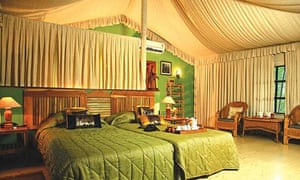
Pench Jungle Camp Pench Jungle Camp’s 12 air-conditioned safari tents and three cottages are dotted among 12 acres of lush foliage and lawns. With its own eco-park, a large lounge area with well-stocked library, manicured lawns and warm hospitality, this camp makes for a memorable stay. • +91 99997 42000, +91 11 2611 9096, wildlife-camp-india.com, £60pn, based on twin sharing, including buffet meals, horse riding, nature walk, one Jeep safari a day and all taxes.
Satpura Tiger Reserve, Madhya Pradesh
Spread over the Satpura ranges and rising to 1,352m at its highest point, this relatively new, little-known scenic reserve has the distinction of being set up for walking and also kayaking on its large reservoir – something too few parks offer. Though harbouring tigers, it’s better known for sightings of leopard, wild dog and sloth, as well as endemic butterflies among its forest-clad hills, steep gorges and many creeks. Likelihood of seeing tigers: low
Reni Pani This collection of 12 cottages is set in 30 acres of forest, with golden meadows, waterholes and a stream. After a day spent walking in the park, take a dip in the pool, then savour local fare around a campfire. During night game drives, visitors regularly spot India’s seldom-seen nocturnal species, including leopard, hyena, wolf and porcupine. • +91 80850 21925, renipanijunglelodge.com, doubles £240 (excluding 7.42% service tax) including all meals, soft drinks, two safaris a day); singles £190. Prices are negotiable with discounts of up to 30% sometimes available.

Forsyth Lodge Under the watchful eye of its naturalist owner, Hashim Tyabji, 44 acres of reclaimed land have been transformed into a verdant landscape, with spotted deer, a resident sloth and a profusion of birds benefiting from its well-thought-out restoration. Detached en suite rooms, clad in local wattle and daub, are set around a swimming pool. Fireplaces, a library devoted to Indian wildlife and a first-floor terrace bar with great views over the Satpura hills add to the atmosphere. • +91 124 4062 480, forsythlodge.com, £120pp, two sharing, with all meals, tea, coffee, game drives, wilderness walks and one elephant safari , excludes transfers, alcohol and other activities.
Kanha Tiger Reserve, Madyha Pradesh
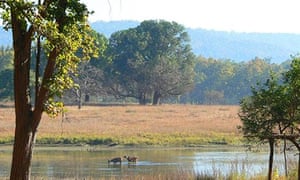
Barasingha deer in the Kanha Tiger Reserve
The four main ranges at Kanha, one of the best-known and oldest of India’s parks, offer the visitor a unique insight into the once-great central Indian forests, which harbour herds of gaur (wild cow), spotted deer, barasingha deer and their adversaries, tiger, wild dog and leopard. Large grasslands offer excellent viewing opportunities, and all accommodation is split between two main sites: Mukki Gate and Kisli Gate. Likelihood of seeing tigers: high
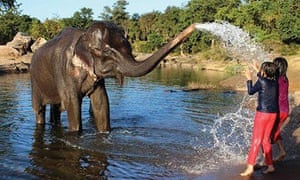
Kipling Camp, Kisli Gate Situated in a glade of trees, this is one of India’s original lodges, a vision of its well-known owner, the late Bob Wright, who opened it in the early 1980s. Many of India’s great and good have enjoyed its warm hospitality over the decades. It’s also home to Tara, an elephant best known for its well-documented wanderings across India with Mark Shand. • +91 11 6519 6377, kiplingcamp.com, £75pp full-board (two sharing)
Kanha Jungle Lodge, Mukki Gate Arriving on a forest pathway, you wonder what to expect, but hidden deep in this forest is a warm welcome from an old-timer, manager Tarun Bhatt and his friendly team. This was the first lodge in Kanha, set up by the Sankhala family, pioneers of Project Tiger in the 1970s. Nights are special inside this forest, with all manner of calls and hoots. • tiger-resorts.com/kanha-jungle-lodge, +91 90981 87253, £275pp, including full-board accommodation in a deluxe cottage, two Jeep safaris a day, elephant ride (subject to availability), guides, entrance fees and taxes
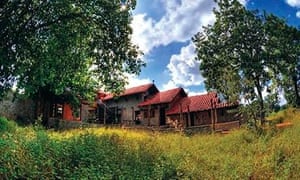
Kanha Earth Lodge, Kisli Gate Set in 16 acres of restored landscape beside one of the park’s many villages, this lodge’s award-winning architecture combines modern comforts with the excitement of wildlife adventure and outdoor living. Combine your game drives with afternoons on a bicycle or experiencing village life in the colourful markets in nearb Sareka or Kumadehi. • +91 88006 37711, kanhaearthlodge.com, £125pp full-board, including taxes, two shared safaris, park entries, guide charges and activities such as cycling and nature walks
Tadoba-Andhari Tiger Reserve, Maharashtra
Little known until recently, this park in northern Maharashtra offers a fascinating view of a central Indian jungle, and is open all year. Its two lakes and open waterholes ensure a booming population of tigers (around 70), leopards and sloths. There are excellent birding opportunities, too, with around 200 species to spot, including the grey-headed fish eagle, the crested serpent eagle and the changeable hawk-eagle. Likelihood of seeing tigers: high
Tiger Trails Jungle Lodge Tiger Trails Jungle Lodge is set in 20 acres within a larger conservation area on the park’s borders and at a major crossing point for many of Tadoba’s mammals. Tigers, leopards, wild dogs and their wary prey are often caught on hidden cameras and CCTV, with their images broadcast live in the lounge. A winner of TofTigers’ most inspirational eco-lodge award in 2012, the lodge’s wildlife protection and conservation efforts have seen sightings increase from two a day 30 years ago to 20 a day now. • +91 98229 30703, +91 98230 12707, tigertrails.in, £60pp full-board (two sharing), £45 extra for Jungle Plan, with excursions
Kaziranga National Park, Assam
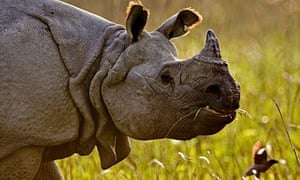
In Assam, the north-eastern state that shares borders with Bangladesh and Bhutan, these Bramaputra floodplains of tall elephant grass are home to large numbers of Indian one-horned rhinoceros and wild Asian elephants, as well as some of the last herds of wild buffalo left in the world. Realistically, spotting a tiger is unlikely, though numbers are good and sightings are becoming more common. It remains a goof park for seeing other Indian greats, and birdlife is prolific, too. Likelihood of seeing tigers: low
Diphlu River Lodge Built on stilts amid fields and overlooking the floodplains beyond, this lodge is a place where you can spot rhinos from your room within a thatched cottage. Guides are on hand to lead tours of the surrounding wilds, and you can also take boat safaris (from October to the end of June) to spot playful Gangetic dolphins. • +91 92070 42330, diphluriverlodge.com , £130pp full-board (two sharing), including safaris, park entrance fees and taxes, dolphin boat trip extra
Nagarhole Tiger Reserve, Karnataka
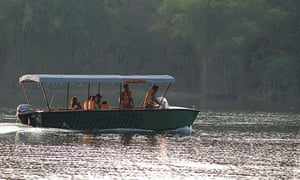
Nagarhole is home to the largest concentration of Asian elephants in the world. Tigers, leopards and dhole (wild dog) also live in these forests – all three co-existing in this biodiverse part of south-west India called the Western Ghats. Likelihood of seeing tigers: good
Orange County Inspired by tribal villages, the picturesque resort is bordered on two sides by the Kabini river. Relax after your game drive in one of its palm-thatched rooms, or soak in your own hot tub. As elephant herds come down to drink from the river, you can get up close by in a coracle boat. You can also explore the area by bike or, extra slowly, in a bullock cart. • +91 8228 269 100, orangecounty.in, £145pp full-board (two sharing), £15 extra for jungle plan, which includes safari charges
Bandipur Tiger Reserve, Karnataka
This reserve falls within India’s largest contiguous forest, which also includes Nagarhole. Bandipur is in the south Indian state of Karnataka, within a very scenic stretch of the Western Ghats. Likelihood of seeing tigers: good
Dhole’s Den This a small, award-winning and very contemporary homestay, with only five rooms – including one suite and two bungalow villas – on the edge of the park. Offering unhindered views of the Nilgiri hills beyond, it is built to high environmental standards, including solar- and wind-powered energy, rainwater harvesting and reed-bed filtration. Mix your safari with village visits and meals made with fresh produce from the lodge’s organic farm. For the more intrepid, they also offer camping experiences. • +91 8229 236062, dholesden.com, doubles £100 a night full-board, including one nature walk but not transfers and drinks. Safaris are an additional £25pp.
Nagzira Wildlife Sanctuary, Maharashtra
This small and little-known reserve is set within the Vidarbha mountain range, in the north-east corner of Maharashtra. Its rocky and undulating terrain is covered with thick teak forests, which support healthy populations of carnivores, including tigers, leopards, jackals and hyenas. Likelihood of seeing tigers: good
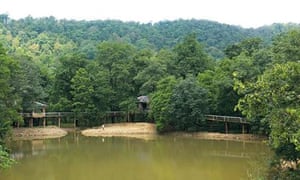
Muba Jungle Camp This camp is a short drive from the park gate, yet deep inside lush green forest and surrounded by beautiful mountains. Built up high, along 12ft walkways, it offers a bird’s eye view of the jungle. Enjoy jeep safaris and nature walks, fascinating village tours, bullock cart rides and trekking with an in-house naturalist. • +91 09770623046, + 91 09303037453, mubaresorts.com , £28pp full-board (two sharing)
Sundarbans Tiger Reserve, West Bengal
Famous for its vast, low-lying mangrove estuary, the Sundarbans national park is also home to an astonishing range of flora and fauna, on its muddy banks. Its numerous tigers – 70 at the last census – and lots of smaller cats, including the fishing and leopard cat, hide themselves well, but you can often see the highly endangered Irrawaddy dolphin, sharks and even saltwater crocodiles. It’s a place for lovers of nature, not for first-time safari goers. If you spot a tiger here, it’s a real treat. Likelihood of seeing tigers: low
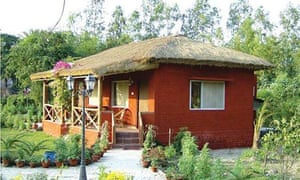
Sunderban Tiger Camp On the island of Dayapur, on the banks of the Pitchkhal river, Sunderban Tiger Camp is a good-value base for exploring these astonishing surroundings. Pick one of the air-conditioned cottages for more comfortable nights – the year-round humidity is a real sleep sapper. Carry good binoculars to view migratory birds on the lake, tootle up river on a boat safari, plant saplings with the gardeners, but remember that any exploration on foot is fraught with tap roots everywhere, like trip wires. • +91 33 3293 5749, +91 98308 67600, waxpolhotels.com/sunderban-accommodation, £54pp (two sharing) with all meals and jungle plan
All parks are open October to June, except Tadoba-Andhari Tiger Reserve, which is open all year. You can view all 43 certified tiger lodges at toftigers.org and download the Good Wildlife Travel Guide
Published in Guardian in Dec 2013 https://www.theguardian.com/travel/2013/dec/05/guide-to-indias-tiger-reserves-conservation





